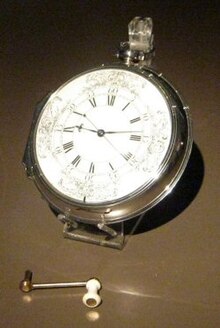William Harrison (instrument maker)
In his will, drafted shortly before his death, William Harrison acknowledged his late father's sole invention of the H4 chronometer, yet asserted their joint involvement in its creation by stating the watch had been 'made by him and me conjointly...'[1] He demonstrated his own inventive talents as early as 1757 when, as a watchmaker residing at Red Lion Square in London, he patented shock-absorbing springs that significantly improved the safety and comfort of carriage passengers.
[2] Later, he collaborated with the textile machinery manufacturer Peter Atherton on a patent related to a method for making screws and machines used in producing mathematical instruments.
[3][4] Harrison and Atherton subsequently became business partners in textile manufacturing, collaborating on ventures in the Greenfield Valley, near Holywell, Flintshire, and at Kirk Mill, in Chipping, Lancashire.
For many years he was a Prominent Governor of the Foundling Hospital, teaching music to the children, and was appointed High Sheriff of Monmouthshire in 1791" [8] Ian Hart portrayed William Harrison in the 2000 TV miniseries Longitude, with Liam Jennings as a younger version of the character.
The critically acclaimed series, directed by Charles Sturridge and based on the 1995 book of the same title by Dava Sobel, starred Michael Gambon as John Harrison and Jeremy Irons as twentieth-century horologist Rupert Gould.

